Do you have a question about the Carrier Ecologic 30HXC076-271 and is the answer not in the manual?
Covers hazards during installation, servicing, and general safety practices like wearing PPE.
Multiple warnings regarding electrical shock, control system bypass, and wiring.
Warnings about venting refrigerant, flammable oil, and handling refrigerant lines.
Core module controlling operation, receiving input/output from other modules.
Controls oil heater, outdoor fan, and minimum load on 30GX units.
Operates electronic expansion devices and reports status.
Monitors compressor safeties and controls outputs for each compressor.
Used as an input/output module without operating software.
Interface for operator communication and control.
Selects unit operating mode (Local, Off, Remote).
Controls refrigerant flow via stepper motor for precise level maintenance.
Prelubricates compressors before start-up to ensure sufficient oil pressure.
Uses flash gas or solenoid valve to cool compressor motor windings.
Ensures sufficient system pressure for oil return to the compressor.
Gathers data for chiller operation control, monitoring pressure, temperature, and liquid level.
Uses a factory-installed starter assembly with 3 contactors for reduced starting current.
Simplest starting method using a single contactor for motors designed for continuous operation.
Displays time remaining before unit start, influenced by various conditions.
User-configurable delay for unit operation after power restoration or compressor restart.
Describes the sequence for starting compressors and loaders for optimal chiller efficiency.
Configurable choice for determining which circuit leads or lags based on starts and operating hours.
Configurable as equal or staged circuit loading for capacity step changes.
Initiates first stage of capacity and is used for the last stage before circuit shutdown.
Overrides that modify the normal operation of the capacity control routine.
Limits the rate of change of leaving fluid temperature to prevent compressor overloading.
Reduces unit capacity when entering fluid temperature is below the control point.
Adjusts EXV opening or unloads circuit based on discharge superheat levels.
Prevents unit capacity increase or shuts down circuit to avoid cooler freezing.
Cycles loaders or shuts down compressor to control condensing temperature.
Reduces capacity stages or lowers EXV position as system pressures approach set parameters.
Controls condenser fans or water valves to maintain saturated condensing temperature.
Details fan staging for air-cooled units, referencing Fig. 5.
Controls condenser fans based on Saturated Condensing Temperature and Head Pressure Set Point.
Optional controller for low-ambient operation, managing head pressure via PID loop.
Controls water valves using 4-20 mA or 2-10 VDC signals based on condensing temperature.
Controls cooler pump based on occupied mode or freeze protection.
Describes two methods for condenser pump control: occupied mode or compressor start/stop.
Activates cooler heaters only when the chiller is in a saturated suction temperature freeze condition.
Brief description of the function and operative keys on the keypad.
Provides an example of how to navigate and access subfunctions.
Describes the rotating display that appears after 10 minutes of inactivity.
Displays diagnostic codes and current operating information about the machine.
Used for testing operating analog and discrete outputs.
Used for entering occupied/unoccupied schedules for unit operation.
Used for entering configuration information and enabling manual control.
Used for displaying run time, cycles, and previous alarms.
Used for entering operating set points and day/time information.
Messages indicating faults that cause unit shutdown, termination, or default value usage.
Displays control mode, run status, CCN status, and current alarms.
Displays current system operating conditions such as pressures and temperatures for Circuit A.
Shows On/Off status of compressor(s), loaders, solenoids, and pumps for Circuit A.
Shows status of condenser fans, demand limit settings, and pump status.
Indicates the unit's operating status, such as Local On/Off or CCN On.
Displays load/unload factor, control point, and leaving water temperature.
Displays dual chiller control status, including Master/Slave configuration and lead/lag information.
Displays current alarms and allows resetting them.
Displays control mode, run status, CCN status, and current alarms.
Displays total capacity, discharge pressure, suction pressure, and oil pressure for Circuit A.
Displays SAT condensing temp, saturated suction temp, EXV percent open, and water valve position for Circuit A.
Shows compressor, loader, oil heater, and motor cooling solenoid status for Circuit A.
Displays total capacity, discharge pressure, suction pressure, and oil pressure for Circuit B.
Displays motor temperature, SAT condensing temp, EXV percent open, and cooler level indicator for Circuit B.
Shows compressor, loader, oil heater, and motor cooling solenoid status for Circuit B.
Displays entering and leaving fluid temperatures for the cooler and condenser.
Displays temperature reset, demand limit signals, and outdoor air temperature.
Shows status of condenser fans, demand limit switches, pump relays, and miscellaneous inputs.
Indicates the unit's operating status, such as Local On/Off or CCN On.
Lists various operating modes like Clock Off, Local On, CCN On, and Dual SP Active.
Displays load/unload factor, control point, and leaving water temperature.
Displays dual chiller control status, including Master/Slave configuration and lead/lag information.
Tests operation of loaders, solenoids, oil pump, and fans.
Tests EXV motor operation and valve movement in 25% increments.
Displays machine operating hours, run time, and starts for the unit and compressors.
Allows entering and changing set points within fixed upper and lower limits.
Tests discrete outputs for Circuit A, including loaders and solenoids.
Tests discrete outputs for Circuit B, including loaders and solenoids.
Tests unit discrete outputs such as fans, cooler pump, condenser pump, and cooler heater.
Tests remote alarm outputs (currently not supported).
Tests EXV valve operation and fan speed for Motormaster controlled units.
Displays machine and compressor operating hours and starts.
Lists the 10 most recent alarms with descriptions, time, and date of occurrence.
Allows setting of cooling, heating, head pressure, demand limit, and minutes off time.
Selects imperial or metric units for temperature and pressure display.
Displays target address and bus number for CCN configurations.
Allows reading and changing the unit's date and time.
Disables CCN control commands, allowing local mode operation.
Allows viewing and entering configuration data, including factory, field, and service configurations.
Requires a password to modify configurations and use manual control subfunction.
Accesses configuration options for various chiller settings and features.
Allows configuration of temperature reset, demand limit, and head pressure PID settings.
Allows entry into factory and service configuration codes for proper unit operation.
Allows viewing transducer calibration information and performing calibration.
Provides full control over compressors, loaders, and minimum load valve for manual operation.
Enables Master/Slave combination of chillers for coordinated operation.
Configures chiller settings like unit type, compressor tonnage, and temperature setpoints.
Configures cooler fluid select, minimum load valve select, and loading sequence.
Configures cooling setpoint select, heating setpoint select, and ramp load select.
Configures clock control, OAT sensor select, and alarm reset select.
Configures cooling and heating reset types, demand limit, and deadband multiplier.
Configures loadshed group number, maximum loadshed time, and PID gains for water valve and motor master.
Displays factory set configuration codes for unit setup.
Allows calibration of pressure transducers for accurate readings.
Enables manual control of compressors, loaders, and minimum load valve.
Configures Master/Slave selection, slave address, and lead/lag balance for dual chiller systems.
Shows the Carrier Software Part Number and revision number.
Configures cooler fluid select, minimum load valve select, and loading sequence.
Provides keypad entry sequence for factory configuration codes.
Provides keypad entry sequence for service configuration codes.
Configures user-defined time periods for automatic switching between occupied and unoccupied modes.
Enables a second cooling set point for ice duty or unoccupied periods.
Configures schedules for ice build operations, including timed overrides.
Configures local time schedules for occupied and unoccupied periods.
Allows configuration of holiday start day and duration for schedule overrides.
Allows configuration of 29 additional holiday periods.
Resets leaving fluid temperature based on return fluid temperature to optimize chiller efficiency.
Resets leaving fluid temperature based on outdoor ambient temperature.
Resets leaving fluid temperature based on a 4 to 20 mA signal input.
Describes three types of demand limiting: switch, 4-20 mA signal, and CCN Loadshed.
Reduces maximum capacity based on the state of two switch inputs.
Selects the type of reset (e.g., degrees reset, remote temp, CHW Delta T).
Enables or disables the selected reset type for cooling.
Configures cooling reset type for externally powered inputs.
Configures cooling reset type for return fluid inputs.
Configures demand limit percentage and select 4-20 mA control.
Configures loadshed group number, demand delta, and maximum loadshed time.
Selects demand limit type (two-step switch, 4-20 mA, or CCN Loadshed).
Checks diagnostic information in Status and Service functions for unit operation.
Procedure to shut off the unit by moving the LOCAL/OFF/REMOTE switch.
Lists potential causes for complete unit stoppage, such as load satisfied or power failure.
Lists causes for single circuit stoppage, such as low oil pressure or thermistor failure.
Steps for restarting the unit after a stoppage, including manual reset requirements.
Unit restarts automatically when power is restored.
Warnings of abnormal conditions assigned code numbers, displayed on HSIO.
Explains how CPM processor controls compressor start/stop based on high-pressure switch.
Lists CPM specific alarms like High Pressure Switch Trip, No Motor Current, and Current Imbalance.
Details specific alarm codes, their causes, actions taken, and probable causes.
Lists CPM specific alarms like Motor Over Temperature and Open Thermistor.
Details specific alarm codes, their causes, actions taken, and probable causes for thermistor and pressure transducer failures.
Details specific alarm codes for oil pressure transducer failure, economizer transducer failure, and voltage issues.
Details alarm codes for condenser freeze protection, loss of condenser flow, illegal configuration, and cooler pump interlock.
Details alarm codes for high discharge pressure, low leaving chilled water temperature, and low oil level.
Lists control points and the action taken when communication is lost.
Lists illegal configuration codes and their descriptions.
Checks EXV motor operation and lead screw movement for proper valve function.
Checks EXV output signals at appropriate terminals on the EXV driver module.
Steps to check the physical operation of an EXV, including motor and lead screw movement.
Accessing the appropriate EXV test step via the HSIO keypad.
Checks float assembly, bubbler tube, and wiring for proper economizer function.
Steps to check the physical operation of an economizer.
Accessing the appropriate EXV test step via the HSIO keypad.
Checks float assembly, bubbler tube, and wiring for proper economizer function.
Procedure for plugging leaky tubes until cooler retubing is necessary.
Guidelines for retubing heat exchangers, including torque specifications.
Procedure for tightening cooler/condenser head bolts with O-ring preparation.
Inspecting and cleaning cooler tubes, checking thermistors for corrosion or scale.
Inspecting and cleaning condenser tubes, checking thermistors for corrosion or scale.
Importance of proper water treatment to prevent corrosion, scaling, and algae.
Methods for cleaning condenser coils using vacuum, water, or compressed air.
Factors to consider when checking for low refrigerant charge, including sight glass and EXV percent open.
Procedure for adding liquid refrigerant charge to 30HXC systems.
Procedure for adding oil to the system if low oil level alarms persist.
Table listing maximum oil charges for different unit sizes.
Step-by-step procedure for replacing the external oil filter.
Procedure for replacing the internal oil filter.
Detailed steps for changing compressors, including electrical and mechanical procedures.
Steps to perform after a compressor motor burnout, including oil removal and filter replacement.
Explains how to interpret moisture indicators and when to replace the filter drier.
Describes the function of the liquid line service valve for field charging.
Aids in verifying thermistor performance by providing resistance values at various temperatures.
Provides instructions for replacing thermistors, including liquid level sensors.
Details the procedure for calibrating pressure transducers using system pressure or atmospheric pressure.
Guides on checking supply voltage and comparing readings to a calibrated gauge.
Covers motor overload protection and compressor protection module functions.
Explains how oil separator heaters operate based on discharge gas temperature.
Details low water temperature safety and freeze protection for the cooler.
Describes the location and function of fusible plugs and pressure relief valves.
Describes the function and diagnostic indicators of the PSIO and DSIO modules.
Explains the meaning of LED indicators on PSIO and DSIO modules for proper operation.
Provides information on connecting the chiller units to the CCN for communication.
Lists symptoms and causes for compressors not running, with remedies.
Lists causes and remedies for compressors cycling off due to low pressure.
Lists causes and remedies for compressors shutting down due to high pressure.
Lists causes and remedies for units operating longer than expected.
Lists common system noises and their probable causes.
Lists causes and remedies for compressors losing oil.
Addresses issues related to hot liquid lines and frosted liquid lines.
Lists causes and remedies for compressor loaders not functioning correctly.
Procedure for replacing a defective PSIO-1 module, including software and configuration transfer.
Steps to prepare the chiller for winter shutdown, including draining fluid and filling with antifreeze.
Checklist for verifying auxiliary components, electrical connections, and refrigerant valves.
Procedure to check incoming power phasing and correct if necessary.
Steps for performing an actual start-up under supervision, including setting temperature and pump operation.
Describes the chiller's operational sequence from start-up to capacity staging.
Diagram showing power supply connections for control circuits.
Wiring diagrams for remote alarm relay accessories.
Wiring diagram for chilled water pump relay on 30HXA,C units.
Wiring diagram for chilled water pump relay on 30GX units.
Wiring diagram for the ground fault interrupter convenience outlet accessory.
Wiring diagrams for oil pump motor junction box control circuits.
Wiring diagrams for minimum load valve accessory control circuits.
Wiring diagrams for condenser pump relay and remote condenser fan control.
Wiring diagram for chilled water interlock and flow switch input.
Wiring diagram for remote on/off switch input.
Wiring for 4-20 mA signal generators for temperature reset and demand limit.
Wiring for condenser flow switch and remote dual setpoint inputs.
Wiring for outdoor air thermistor field supplied input.
Wiring for 4-20 mA signal generators for demand limit and temperature reset.
Wiring for space temperature sensor and demand limit switch inputs.
Wiring diagrams for Motormaster option on Circuits A and B.
Table listing required must trip amps for CPM modules on 2-compressor units.
Continues the table of required must trip amps for CPM modules on 2-compressor units.
Table listing required must trip amps for CPM modules on 3-compressor units.
Tables detailing punch-out configurations and overload settings for CPM modules on 2-compressor units.
Continues tables for punch-out configurations and overload settings for 2-compressor units.
Tables detailing punch-out configurations and overload settings for CPM modules on 3-compressor units.
Continues tables for punch-out configurations and overload settings for 3-compressor units.
Continues tables for punch-out configurations and overload settings for 3-compressor units.
Indicates the unit size ranges for cooler pressure drop charts.
Indicates the unit size ranges for cooler pressure drop charts in SI units.
Indicates the unit size ranges for condenser pressure drop charts.
Indicates the unit size ranges for condenser pressure drop charts in SI units.
Indicates the unit size ranges for cooler pressure drop charts.
Indicates the unit size ranges for cooler pressure drop charts in SI units.
Indicates the unit size ranges for cooler pressure drop charts.
Indicates the unit size ranges for cooler pressure drop charts in SI units.
Defines symbols used in the system component diagrams.
Defines symbols used in the system component diagrams.
Programs for increasing knowledge of equipment through video and materials.
Hands-on training in labs for troubleshooting and callbacks.
Collects basic job information, installing contractor, and equipment model/serial numbers.
Checks for shipping damage, unit installation, electrical wiring, and component connections.
Verifies CWP starter, valve status, leak checks, voltage imbalance, and compressor running current.
Covers hazards during installation, servicing, and general safety practices like wearing PPE.
Multiple warnings regarding electrical shock, control system bypass, and wiring.
Warnings about venting refrigerant, flammable oil, and handling refrigerant lines.
Core module controlling operation, receiving input/output from other modules.
Controls oil heater, outdoor fan, and minimum load on 30GX units.
Operates electronic expansion devices and reports status.
Monitors compressor safeties and controls outputs for each compressor.
Used as an input/output module without operating software.
Interface for operator communication and control.
Selects unit operating mode (Local, Off, Remote).
Controls refrigerant flow via stepper motor for precise level maintenance.
Prelubricates compressors before start-up to ensure sufficient oil pressure.
Uses flash gas or solenoid valve to cool compressor motor windings.
Ensures sufficient system pressure for oil return to the compressor.
Gathers data for chiller operation control, monitoring pressure, temperature, and liquid level.
Uses a factory-installed starter assembly with 3 contactors for reduced starting current.
Simplest starting method using a single contactor for motors designed for continuous operation.
Displays time remaining before unit start, influenced by various conditions.
User-configurable delay for unit operation after power restoration or compressor restart.
Describes the sequence for starting compressors and loaders for optimal chiller efficiency.
Configurable choice for determining which circuit leads or lags based on starts and operating hours.
Configurable as equal or staged circuit loading for capacity step changes.
Initiates first stage of capacity and is used for the last stage before circuit shutdown.
Overrides that modify the normal operation of the capacity control routine.
Limits the rate of change of leaving fluid temperature to prevent compressor overloading.
Reduces unit capacity when entering fluid temperature is below the control point.
Adjusts EXV opening or unloads circuit based on discharge superheat levels.
Prevents unit capacity increase or shuts down circuit to avoid cooler freezing.
Cycles loaders or shuts down compressor to control condensing temperature.
Reduces capacity stages or lowers EXV position as system pressures approach set parameters.
Controls condenser fans or water valves to maintain saturated condensing temperature.
Details fan staging for air-cooled units, referencing Fig. 5.
Controls condenser fans based on Saturated Condensing Temperature and Head Pressure Set Point.
Optional controller for low-ambient operation, managing head pressure via PID loop.
Controls water valves using 4-20 mA or 2-10 VDC signals based on condensing temperature.
Controls cooler pump based on occupied mode or freeze protection.
Describes two methods for condenser pump control: occupied mode or compressor start/stop.
Activates cooler heaters only when the chiller is in a saturated suction temperature freeze condition.
Brief description of the function and operative keys on the keypad.
Provides an example of how to navigate and access subfunctions.
Describes the rotating display that appears after 10 minutes of inactivity.
Displays diagnostic codes and current operating information about the machine.
Used for testing operating analog and discrete outputs.
Used for entering occupied/unoccupied schedules for unit operation.
Used for entering configuration information and enabling manual control.
Used for displaying run time, cycles, and previous alarms.
Used for entering operating set points and day/time information.
Messages indicating faults that cause unit shutdown, termination, or default value usage.
Displays control mode, run status, CCN status, and current alarms.
Displays current system operating conditions such as pressures and temperatures for Circuit A.
Shows On/Off status of compressor(s), loaders, solenoids, and pumps for Circuit A.
Shows status of condenser fans, demand limit settings, and pump status.
Indicates the unit's operating status, such as Local On/Off or CCN On.
Displays load/unload factor, control point, and leaving water temperature.
Displays dual chiller control status, including Master/Slave configuration and lead/lag information.
Displays current alarms and allows resetting them.
Displays control mode, run status, CCN status, and current alarms.
Displays total capacity, discharge pressure, suction pressure, and oil pressure for Circuit A.
Displays SAT condensing temp, saturated suction temp, EXV percent open, and water valve position for Circuit A.
Shows compressor, loader, oil heater, and motor cooling solenoid status for Circuit A.
Displays total capacity, discharge pressure, suction pressure, and oil pressure for Circuit B.
Displays motor temperature, SAT condensing temp, EXV percent open, and cooler level indicator for Circuit B.
Shows compressor, loader, oil heater, and motor cooling solenoid status for Circuit B.
Displays entering and leaving fluid temperatures for the cooler and condenser.
Displays temperature reset, demand limit signals, and outdoor air temperature.
Shows status of condenser fans, demand limit switches, pump relays, and miscellaneous inputs.
Indicates the unit's operating status, such as Local On/Off or CCN On.
Lists various operating modes like Clock Off, Local On, CCN On, and Dual SP Active.
Displays load/unload factor, control point, and leaving water temperature.
Displays dual chiller control status, including Master/Slave configuration and lead/lag information.
Tests operation of loaders, solenoids, oil pump, and fans.
Tests EXV motor operation and valve movement in 25% increments.
Displays machine operating hours, run time, and starts for the unit and compressors.
Allows entering and changing set points within fixed upper and lower limits.
Tests discrete outputs for Circuit A, including loaders and solenoids.
Tests discrete outputs for Circuit B, including loaders and solenoids.
Tests unit discrete outputs such as fans, cooler pump, condenser pump, and cooler heater.
Tests remote alarm outputs (currently not supported).
Tests EXV valve operation and fan speed for Motormaster controlled units.
Displays machine and compressor operating hours and starts.
Lists the 10 most recent alarms with descriptions, time, and date of occurrence.
Allows setting of cooling, heating, head pressure, demand limit, and minutes off time.
Selects imperial or metric units for temperature and pressure display.
Displays target address and bus number for CCN configurations.
Allows reading and changing the unit's date and time.
Disables CCN control commands, allowing local mode operation.
Allows viewing and entering configuration data, including factory, field, and service configurations.
Requires a password to modify configurations and use manual control subfunction.
Accesses configuration options for various chiller settings and features.
Allows configuration of temperature reset, demand limit, and head pressure PID settings.
Allows entry into factory and service configuration codes for proper unit operation.
Allows viewing transducer calibration information and performing calibration.
Provides full control over compressors, loaders, and minimum load valve for manual operation.
Enables Master/Slave combination of chillers for coordinated operation.
Configures chiller settings like unit type, compressor tonnage, and temperature setpoints.
Configures cooler fluid select, minimum load valve select, and loading sequence.
Configures cooling setpoint select, heating setpoint select, and ramp load select.
Configures clock control, OAT sensor select, and alarm reset select.
Configures cooling and heating reset types, demand limit, and deadband multiplier.
Configures loadshed group number, maximum loadshed time, and PID gains for water valve and motor master.
Displays factory set configuration codes for unit setup.
Allows calibration of pressure transducers for accurate readings.
Enables manual control of compressors, loaders, and minimum load valve.
Configures Master/Slave selection, slave address, and lead/lag balance for dual chiller systems.
Shows the Carrier Software Part Number and revision number.
Configures cooler fluid select, minimum load valve select, and loading sequence.
Provides keypad entry sequence for factory configuration codes.
Provides keypad entry sequence for service configuration codes.
Configures user-defined time periods for automatic switching between occupied and unoccupied modes.
Enables a second cooling set point for ice duty or unoccupied periods.
Configures schedules for ice build operations, including timed overrides.
Configures local time schedules for occupied and unoccupied periods.
Allows configuration of holiday start day and duration for schedule overrides.
Allows configuration of 29 additional holiday periods.
Resets leaving fluid temperature based on return fluid temperature to optimize chiller efficiency.
Resets leaving fluid temperature based on outdoor ambient temperature.
Resets leaving fluid temperature based on a 4 to 20 mA signal input.
Describes three types of demand limiting: switch, 4-20 mA signal, and CCN Loadshed.
Reduces maximum capacity based on the state of two switch inputs.
Selects the type of reset (e.g., degrees reset, remote temp, CHW Delta T).
Enables or disables the selected reset type for cooling.
Configures cooling reset type for externally powered inputs.
Configures cooling reset type for return fluid inputs.
Configures demand limit percentage and select 4-20 mA control.
Configures loadshed group number, demand delta, and maximum loadshed time.
Selects demand limit type (two-step switch, 4-20 mA, or CCN Loadshed).
Checks diagnostic information in Status and Service functions for unit operation.
Procedure to shut off the unit by moving the LOCAL/OFF/REMOTE switch.
Lists potential causes for complete unit stoppage, such as load satisfied or power failure.
Lists causes for single circuit stoppage, such as low oil pressure or thermistor failure.
Steps for restarting the unit after a stoppage, including manual reset requirements.
Unit restarts automatically when power is restored.
Warnings of abnormal conditions assigned code numbers, displayed on HSIO.
Explains how CPM processor controls compressor start/stop based on high-pressure switch.
Lists CPM specific alarms like High Pressure Switch Trip, No Motor Current, and Current Imbalance.
Details specific alarm codes, their causes, actions taken, and probable causes.
Lists CPM specific alarms like Motor Over Temperature and Open Thermistor.
Details specific alarm codes, their causes, actions taken, and probable causes for thermistor and pressure transducer failures.
Details specific alarm codes for oil pressure transducer failure, economizer transducer failure, and voltage issues.
Details alarm codes for condenser freeze protection, loss of condenser flow, illegal configuration, and cooler pump interlock.
Details alarm codes for high discharge pressure, low leaving chilled water temperature, and low oil level.
Lists control points and the action taken when communication is lost.
Lists illegal configuration codes and their descriptions.
Checks EXV motor operation and lead screw movement for proper valve function.
Checks EXV output signals at appropriate terminals on the EXV driver module.
Steps to check the physical operation of an EXV, including motor and lead screw movement.
Accessing the appropriate EXV test step via the HSIO keypad.
Checks float assembly, bubbler tube, and wiring for proper economizer function.
Steps to check the physical operation of an economizer.
Accessing the appropriate EXV test step via the HSIO keypad.
Checks float assembly, bubbler tube, and wiring for proper economizer function.
Procedure for plugging leaky tubes until cooler retubing is necessary.
Guidelines for retubing heat exchangers, including torque specifications.
Procedure for tightening cooler/condenser head bolts with O-ring preparation.
Inspecting and cleaning cooler tubes, checking thermistors for corrosion or scale.
Inspecting and cleaning condenser tubes, checking thermistors for corrosion or scale.
Importance of proper water treatment to prevent corrosion, scaling, and algae.
Methods for cleaning condenser coils using vacuum, water, or compressed air.
Factors to consider when checking for low refrigerant charge, including sight glass and EXV percent open.
Procedure for adding liquid refrigerant charge to 30HXC systems.
Procedure for adding oil to the system if low oil level alarms persist.
Table listing maximum oil charges for different unit sizes.
Step-by-step procedure for replacing the external oil filter.
Procedure for replacing the internal oil filter.
Detailed steps for changing compressors, including electrical and mechanical procedures.
Steps to perform after a compressor motor burnout, including oil removal and filter replacement.
Explains how to interpret moisture indicators and when to replace the filter drier.
Describes the function of the liquid line service valve for field charging.
Aids in verifying thermistor performance by providing resistance values at various temperatures.
Provides instructions for replacing thermistors, including liquid level sensors.
Details the procedure for calibrating pressure transducers using system pressure or atmospheric pressure.
Guides on checking supply voltage and comparing readings to a calibrated gauge.
Covers motor overload protection and compressor protection module functions.
Explains how oil separator heaters operate based on discharge gas temperature.
Details low water temperature safety and freeze protection for the cooler.
Describes the location and function of fusible plugs and pressure relief valves.
Describes the function and diagnostic indicators of the PSIO and DSIO modules.
Explains the meaning of LED indicators on PSIO and DSIO modules for proper operation.
Provides information on connecting the chiller units to the CCN for communication.
Lists symptoms and causes for compressors not running, with remedies.
Lists causes and remedies for compressors cycling off due to low pressure.
Lists causes and remedies for compressors shutting down due to high pressure.
Lists causes and remedies for units operating longer than expected.
Lists common system noises and their probable causes.
Lists causes and remedies for compressors losing oil.
Addresses issues related to hot liquid lines and frosted liquid lines.
Lists causes and remedies for compressor loaders not functioning correctly.
Procedure for replacing a defective PSIO-1 module, including software and configuration transfer.
Steps to prepare the chiller for winter shutdown, including draining fluid and filling with antifreeze.
Checklist for verifying auxiliary components, electrical connections, and refrigerant valves.
Procedure to check incoming power phasing and correct if necessary.
Steps for performing an actual start-up under supervision, including setting temperature and pump operation.
Describes the chiller's operational sequence from start-up to capacity staging.
Diagram showing power supply connections for control circuits.
Wiring diagrams for remote alarm relay accessories.
Wiring diagram for chilled water pump relay on 30HXA,C units.
Wiring diagram for chilled water pump relay on 30GX units.
Wiring diagram for the ground fault interrupter convenience outlet accessory.
Wiring diagrams for oil pump motor junction box control circuits.
Wiring diagrams for minimum load valve accessory control circuits.
Wiring diagrams for condenser pump relay and remote condenser fan control.
Wiring diagram for chilled water interlock and flow switch input.
Wiring diagram for remote on/off switch input.
Wiring for 4-20 mA signal generators for temperature reset and demand limit.
Wiring for condenser flow switch and remote dual setpoint inputs.
Wiring for outdoor air thermistor field supplied input.
Wiring for 4-20 mA signal generators for demand limit and temperature reset.
Wiring for space temperature sensor and demand limit switch inputs.
Wiring diagrams for Motormaster option on Circuits A and B.
Table listing required must trip amps for CPM modules on 2-compressor units.
Continues the table of required must trip amps for CPM modules on 2-compressor units.
Table listing required must trip amps for CPM modules on 3-compressor units.
Tables detailing punch-out configurations and overload settings for CPM modules on 2-compressor units.
Continues tables for punch-out configurations and overload settings for 2-compressor units.
Tables detailing punch-out configurations and overload settings for CPM modules on 3-compressor units.
Continues tables for punch-out configurations and overload settings for 3-compressor units.
Continues tables for punch-out configurations and overload settings for 3-compressor units.
Indicates the unit size ranges for cooler pressure drop charts.
Indicates the unit size ranges for cooler pressure drop charts in SI units.
Indicates the unit size ranges for condenser pressure drop charts.
Indicates the unit size ranges for condenser pressure drop charts in SI units.
Indicates the unit size ranges for cooler pressure drop charts.
Indicates the unit size ranges for cooler pressure drop charts in SI units.
Indicates the unit size ranges for cooler pressure drop charts.
Indicates the unit size ranges for cooler pressure drop charts in SI units.
Defines symbols used in the system component diagrams.
Defines symbols used in the system component diagrams.
Programs for increasing knowledge of equipment through video and materials.
Hands-on training in labs for troubleshooting and callbacks.
Collects basic job information, installing contractor, and equipment model/serial numbers.
Checks for shipping damage, unit installation, electrical wiring, and component connections.
Verifies CWP starter, valve status, leak checks, voltage imbalance, and compressor running current.

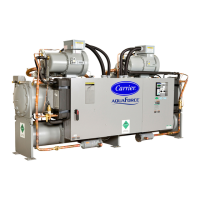
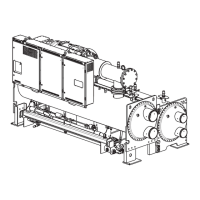
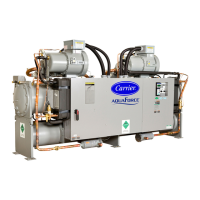
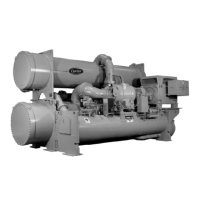


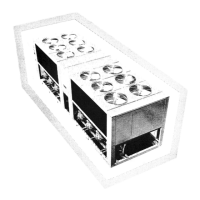


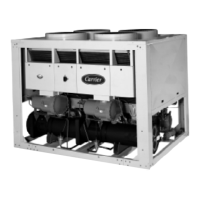

